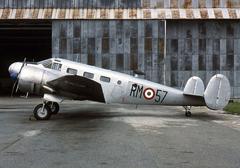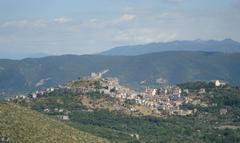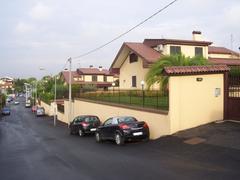Villalba Guidonia Montecelio: Complete Guide to Visiting Hours, Tickets, and Historical Sites
Date: 15/06/2025
Introduction
Villalba, a vibrant district within the Metropolitan City of Rome and part of Guidonia Montecelio, stands out for its unique blend of historical heritage, cultural diversity, and a strong sense of community. From its agricultural origins as Località Barozze, renowned for travertine marble transport, to its transformation amidst Italy’s 20th-century urban expansion, Villalba tells a compelling story of resilience and adaptation (Il Territorio; Wikipedia). This guide offers a detailed overview of Villalba’s history, key landmarks, practical visitor details, accessibility, major events, and the broader attractions of Guidonia Montecelio, including the celebrated Villa Gregoriana in Tivoli.
Table of Contents
- Early Origins and Rural Foundations
- The Fascist Era and Urban Development
- The Galante Family and Community Formation
- Administrative Recognition and Urban Growth
- Cultural Identity and Social Fabric
- Visitor Information
- Exploring Historical Casali
- Urban Renewal and Green Spaces
- Gastronomy and Local Flavors
- Artistic and Literary Heritage
- Preservation Efforts and Challenges
- Getting There and Accessibility
- Nearby Attractions
- Main Attractions in Guidonia Montecelio
- Visiting Villa Gregoriana
- FAQs
- Conclusion and Visitor Tips
- References and Further Reading
Early Origins and Rural Foundations
Villalba’s history predates the modern establishment of Guidonia Montecelio. Originally named “Località Barozze,” the area featured scattered casali (farmsteads) and extensive agricultural estates. The locality’s name derives from the “barozze”—large carts used to transport travertine marble, a resource integral to Rome’s architectural legacy (Il Territorio). This deep connection to the stone industry shaped the region’s identity and economic foundation.
The Fascist Era and Urban Development
Villalba’s transition from rural outpost to structured urban community aligned with the establishment of Guidonia Montecelio in 1937. The period witnessed extensive land reclamation and infrastructure development (Wikipedia). The first residential areas emerged along Via delle Cave, attracting workers from the bustling quarries and local industries.
The Galante Family and Community Formation
Central to Villalba’s early community was the Galante family, who migrated from Sicily and became key figures in local development. Pietro Galante played a pioneering role, and his granddaughter, Vittoria (“Nonna Vittoria”), holds the distinction of being the first native born in Villalba in 1933—before the official founding of the municipality (Tiburno). In 1951, Gaspare Galante donated land for the first chapel, which became a focal point for social and religious life.
Administrative Recognition and Urban Growth
Villalba achieved official recognition as a distinct locality on August 9, 1950, when it was renamed from “Località Barozze” to Villalba. The following decades saw rapid population growth, driven by Italy’s postwar economic expansion and waves of migration from regions such as Abruzzo and Sicily (Tiburno).
Cultural Identity and Social Fabric
Villalba today reflects a rich tapestry of working-class traditions and multicultural influences. Community events, such as the annual celebration of Nonna Vittoria’s birthday, underscore a strong sense of identity and belonging. Numerous churches and cultural centers contribute to the area’s vibrant communal life.
Visitor Information
Visiting Hours and Access
Villalba is an open-access district, welcoming visitors throughout the year. Religious sites, including the first chapel on Via Puglie and the Church of San Michele Arcangelo, observe regular service hours—parish schedules can be checked for specific visiting times (Parrocchia San Michele Arcangelo).
Tickets and Guided Tours
There are generally no entrance fees for exploring Villalba’s public spaces or parks. Guided tours focusing on the district’s history and cultural assets are occasionally available through local organizations or the Guidonia Montecelio tourist office (Comune di Guidonia Montecelio).
Accessibility
Most modern streets and parks offer good accessibility for visitors, though some historical casali and older buildings may feature uneven terrain or limited wheelchair access. For specific needs, contact the local tourist office.
Getting There
- By Train: The closest station is Bagni di Tivoli, easily reached from Rome Tiburtina.
- By Bus: Regional buses connect Villalba with Rome, Guidonia, and Tivoli.
- By Car: Accessible via Via Tiburtina; parking is available near Piazza della Repubblica.
Exploring Historical Casali
Villalba’s casali are living monuments to its agricultural and artistic past:
- Casale Bernini (Casale Nuovo): Associated with Gian Lorenzo Bernini, reflecting Baroque heritage.
- Casale del Barco: Formerly linked to Cardinal Ippolito II d’Este, significant in the travertine trade.
- Casale dei Gelsi (delle More): Known for mulberry trees and rural traditions.
- Casale Sant’Antonio: The oldest casale, showcasing medieval rural life (Il Territorio).
Self-guided walks are possible; some casali can be accessed during special events or guided tours.
Urban Renewal and Green Spaces
Recent revitalization projects have enhanced Villalba’s parks and public spaces, notably Parco Paolo Di Nella and Parco San Gabriele, making them ideal for families and nature enthusiasts (Tiburno). These parks provide excellent opportunities for photography and relaxation.
Gastronomy and Local Flavors
Villalba’s food scene reflects a fusion of Lazio, Sicilian, and Abruzzese traditions. Local trattorias offer specialties such as porchetta, cacio e pepe, and regional pastries (Audiala). The weekly market and food festivals provide a taste of authentic local life.
Artistic and Literary Heritage
Villalba’s connection to Gian Lorenzo Bernini and Cardinal Ippolito II d’Este highlights its artistic significance (Il Territorio). Literary competitions and cultural initiatives further enrich the district’s creative landscape.
Preservation Efforts and Challenges
Preserving Villalba’s historic casali amid urban growth remains a community priority. Local associations actively promote restoration and cultural awareness to safeguard these heritage sites for future generations (Il Territorio).
Getting There and Accessibility
Villalba is well-connected by regional trains, buses, and main roads. Public transport links make it easy to combine a visit with other attractions in Guidonia Montecelio and Tivoli. The district is generally accessible, though historic sites may present some mobility challenges.
Nearby Attractions
Villalba is an excellent base for exploring:
- Travertine Quarries: Experience the marble industry’s legacy.
- Guidonia Air Base: For those interested in aviation history.
- Villanova, Colle Fiorito, Setteville: Neighboring districts with unique character.
- UNESCO World Heritage sites: Villa Adriana and Villa d’Este in Tivoli (Wild Trips).
Main Attractions in Guidonia Montecelio
Montecelio Old Town
A medieval hilltop village with stone houses, winding lanes, and the Church of San Giovanni Evangelista. Guided tours of the fortress ruins are available (Comune di Guidonia Montecelio).
Church of San Michele Arcangelo
A symbol of postwar Villalba, open Monday–Saturday. Regular religious and cultural events are held (Parrocchia San Michele Arcangelo).
Archaeological Area of the Roman Aqueducts
Near Albuccione, visitors can see remnants of the Anio Vetus and Aqua Marcia aqueducts. Guided tours available via the Soprintendenza Archeologia, Belle Arti e Paesaggio.
Parco Naturale Regionale dei Monti Lucretili
A haven for hikers and nature lovers with trails, panoramic views, and diverse flora.
Museums and Cultural Centers
- Museo Civico Archeologico Rodolfo Lanciani: Showcasing local history, Roman artifacts, and medieval finds. Open Tuesday–Sunday, with guided tours available (Museo Civico Archeologico Rodolfo Lanciani).
- Centro Culturale Villalba: Hosts art exhibitions and concerts (Centro Culturale Villalba).
Family-Friendly Activities
- Parco di Via Trento: Playgrounds and sports.
- Guidonia Air Base and Aviation Museum: Occasional tours (Aeronautica Militare).
Religious and Food Festivals
- Festa di San Michele Arcangelo: September festival with processions, music, and food.
- Sagra della Porchetta: Celebrated in summer.
Shopping and Markets
- Mercato Settimanale di Villalba: Thursday market for fresh produce and local goods.
- Bakeries and Gelaterie: Sample traditional maritozzi and gelato.
Visiting Villa Gregoriana
History and Significance
Villa Gregoriana, in nearby Tivoli, was commissioned by Pope Gregory XVI in the 19th century to reclaim the Aniene river gorge. Today, it blends waterfalls, Roman ruins, and lush greenery, making it a highlight for visitors seeking nature and history (Villa Gregoriana).
Visiting Hours and Tickets
- Open: 9:00 AM–7:00 PM (April–October); winter hours vary.
- Tickets: €8 adults, discounts for children/seniors.
- Purchase: Online or at the entrance.
Getting There
- Train: Rome Tiburtina to Tivoli, then walk/bus.
- Car: Via SS5 Tiburtina Valeria; parking available.
- Bus: Cotral lines from Guidonia Montecelio and Rome.
What to See
- Waterfalls and Trails: Scenic cascades and hiking.
- Roman Ruins: Ancient temples and aqueducts.
- Caves: Guided visits available.
Special Events and Photography
Seasonal concerts and festivals are held, especially in June. The park’s landscapes and ruins provide excellent photo opportunities.
Accessibility
Some trails are steep and uneven; contact the park for details if you have mobility needs.
FAQs
Q: What are Villalba’s general visiting hours?
A: The district is open year-round. Parks are open 8:00 AM–sunset; churches and casali may have limited or event-based hours.
Q: Do I need tickets for historical sites?
A: Most sites are free; guided tours or special events may require tickets.
Q: Are guided tours available?
A: Yes; contact the Guidonia Montecelio tourist office or local associations for details.
Q: What is the best time to visit?
A: Spring and early autumn offer pleasant weather and local festivals.
Q: Is Villalba accessible by public transport?
A: Yes—regional trains and buses connect Villalba with Rome and Tivoli.
Conclusion and Visitor Tips
Villalba exemplifies the rich historic and cultural landscape of Guidonia Montecelio and Lazio. From the enduring legacy of the Galante family and the town’s casali, to vibrant community life and green spaces, Villalba offers an immersive experience off the standard tourist trail. Combine your visit with nearby medieval towns, archaeological marvels, and the natural wonders of Villa Gregoriana for a truly enriching journey.
For up-to-date visitor information, guided tour bookings, and cultural events, download the Audiala app and follow local tourism channels.
References and Further Reading
- Villalba di Guidonia - Il Territorio
- Villalba Casali Antichi - Il Territorio
- Guidonia: Auguri Nonna Vittoria - Tiburno
- Riqualificazione Parchi di Villalba - Tiburno
- Guidonia Montecelio - Wikipedia
- Villalba (Guidonia Montecelio) - Wikipedia IT
- Comune di Guidonia Montecelio
- Villa Gregoriana - Official Site
- Wild Trips: Guidonia Montecelio Top Attractions
- Audiala - Guidonia Montecelio
- Museo Civico Archeologico Rodolfo Lanciani
- Centro Culturale Villalba
- Aeronautica Militare
- Outdooractive Guidonia Montecelio Guide
- Italia-Italy Guidonia Montecelio Tourism
- Try Travel: Things to Do in Guidonia Montecelio
- Soprintendenza Archeologia, Belle Arti e Paesaggio
- Trenitalia


